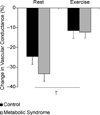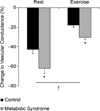Neural control of blood flow during exercise in human metabolic syndrome
- PMID: 24659613
- PMCID: PMC4162814
- DOI: 10.1113/expphysiol.2014.078048
Neural control of blood flow during exercise in human metabolic syndrome
Abstract
α-Adrenergic-mediated vasoconstriction is greater during simulated exercise in animal models of metabolic syndrome (MetSyn) when compared with control animals. In an attempt to translate such findings to humans, we hypothesized that adults with MetSyn (n = 14, 35 ± 3 years old) would exhibit greater α-adrenergic responsiveness during exercise when compared with age-matched healthy control subjects (n = 16, 31 ± 3 years old). We measured muscle sympathetic nerve activity (MSNA; microneurography) and forearm blood flow (Doppler ultrasound) during dynamic forearm exercise (15% of maximal voluntary contraction). α-Adrenergic agonists (phenylephrine and clonidine) and an antagonist (phentolamine) were infused intra-arterially to assess α-adrenergic receptor responsiveness and restraint, respectively. Resting MSNA was ∼35% higher in adults with MetSyn (P < 0.05), but did not change in either group with dynamic exercise. Clonidine-mediated vasoconstriction was greater in adults with MetSyn (P < 0.01). Group differences in vascular responses to phenylephrine and phentolamine were not detected (P > 0.05). Interestingly, exercise-mediated vasodilatation was greater in MetSyn (P < 0.05). Adults with MetSyn exhibit greater resting MSNA and clonidine-mediated vasoconstriction, yet preserved functional sympatholysis and higher exercise blood flow during low-intensity hand-grip exercise when compared with age-matched healthy control subjects. These results suggest that adults with MetSyn exhibit compensatory vascular control mechanisms capable of preserving blood flow responses to exercise in the face of augmented sympathetic adrenergic activity.
© 2014 The Authors. Experimental Physiology © 2014 The Physiological Society.
Figures




References
-
- Alberti KG, Eckel RH, Grundy SM, Zimmet PZ, Cleeman JI, Donato KA, Fruchart JC, James WP, Loria CM, Smith SC., Jr Harmonizing the metabolic syndrome: a joint interim statement of the International Diabetes Federation Task Force on Epidemiology and Prevention; National Heart, Lung, and Blood Institute; American Heart Association; World Heart Federation; International Atherosclerosis Society; and International Association for the Study of Obesity. Circulation. 2009;120:1640–1645. - PubMed
-
- Ardévol A, Adán C, Remesar X, Alemany M, Fernández-López JA. Muscle blood flow during intense exercise in the obese rat. Arch Physiol Biochem. 1996;104:337–343. - PubMed
-
- Beltowski J. Leptin and the regulation of endothelial function in physiological and pathological conditions. Clin Exp Pharmacol Physiol. 2012;39:168–178. - PubMed
-
- Bristow MR, Ginsburg R, Minobe W, Cubicciotti RS, Sageman WS, Lurie K, Billingham ME, Harrison DC, Stinson EB. Decreased catecholamine sensitivity and β-adrenergic-receptor density in failing human hearts. N Engl J Med. 1982;307:205–211. - PubMed
Publication types
MeSH terms
Substances
Grants and funding
LinkOut - more resources
Full Text Sources
Other Literature Sources
Medical

